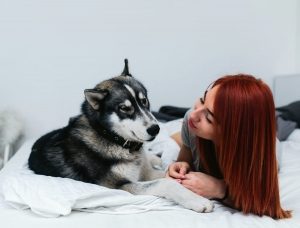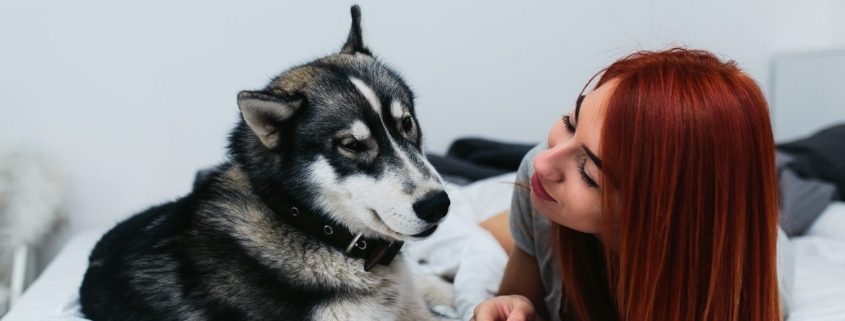Ask Crystal: My Dog Wants to Hump all the Dogs He Meets but Never Wants to Cuddle with his Humans
Welcome to “Ask Crystal,” where you can ask your pet behavior questions! You can submit your question for Crystal at the bottom of the page!
Two questions, please:
- My wonderful, rescued black lab, fixed, wants to hump all the canines to whom he comes into contact. What can I do?
- This rescue fellow is NOT cuddly and everyone in the family wants him to cuddle. What can I do to make that happen? We really love our Beauregard who my husband calls Disregard.
Sincerely,
Disregarding Beauregard
Dear Disregarding,
Wow, you have two very opposing issues with your lovable lab. Overly friendly with canines and not friendly enough with those of the human persuasion.
Humping or mounting behavior is often a response to stress, anxiety and/or excitement. We see this behavior a lot in the shelter play groups and you will likely see a good amount of it at any local dog park. The stress and excitement of meeting new dogs is a classic cause of mounting behavior. It is a natural social behavior and often a stress reliever for many dogs.
Some dogs may mount in an attempt to get attention. Remember that any attention to a dog can be reinforcing to a dog so you yelling for him to get off of the other dog may be the attention he is craving.
There are some medical causes of excessive humping which include urinary tract infections, urinary incontinence, priapism, and skin allergies. If you notice your dog excessively licking, chewing, rubbing or mounting, you may want to take them to a veterinarian to rule out any medical causes.
Based on what you have told me, it seems like the behavior only is occurring when he is meeting dogs so it is likely stress and excitement related. If he has been practicing this behavior for a long time it will be more difficult to change. The first step is to prevent the behavior when you are not able to actively train him. That means putting up baby gates or having him in a crate those times when you cannot attend to his behavior. In order to change this behavior, I would suggest that you put either a tab which is a 4-6-inch leash or a drag line which is a 4-6-foot nylon line. Invite over a friend with a tolerant dog to help you train your dog. Pay attention to the signals that your dog is about to mount the other dog. Usually they sidle up to the other dog, they may put their head on the other dog’s shoulders or place a paw on their back prior to the actual mounting. When you see those signals, grab the tab and cheerfully say “time out” and walk your dog over to a quiet spot to calm down. It is easier to stop the behavior if you can stop it before he really gets involved in the act. You may need to have your friend hold their dog’s leash to avoid their dog running over to play. When your dog is calm, let him play again. Stay close by at all times so you can intervene any and all times he is about to mount. Another option would be to teach him a leave it cue and tell him to leave it when he is showing signs he is about to mount. Reward with treats heavily when he leaves the other dog. Be aware that you will need to do a lot of training in low distraction environments and situations to expect him to be able to listen to that cue in such an exciting situation. I would suggest avoiding any situations in which you cannot apply a time out for humping behavior until the behavior is under control.
 Whether a dog is cuddly or not is usually fairly dependent on that dog’s personality. It can also be affected by how the dog was interacted with as a puppy. I have two dogs at the moment, Ludo and Phoenix. Ludo is my new 4-year-old Doberman and he is probably the cuddliest dog I have ever met. He doesn’t discriminate between his family and strangers. If you have a lap he will put his head in it. My dog Phoenix is a 14-year-old heeler who came to me as a pup with some handling issues. She would growl when being picked up or restrained. I spent many hours training and bonding with her so that she would trust me and those issues did resolve. She will snuggle with me when she feels like it and the second I stop petting her she moves away. There is definitely an element of personality to how much and how a dog will cuddle.
Whether a dog is cuddly or not is usually fairly dependent on that dog’s personality. It can also be affected by how the dog was interacted with as a puppy. I have two dogs at the moment, Ludo and Phoenix. Ludo is my new 4-year-old Doberman and he is probably the cuddliest dog I have ever met. He doesn’t discriminate between his family and strangers. If you have a lap he will put his head in it. My dog Phoenix is a 14-year-old heeler who came to me as a pup with some handling issues. She would growl when being picked up or restrained. I spent many hours training and bonding with her so that she would trust me and those issues did resolve. She will snuggle with me when she feels like it and the second I stop petting her she moves away. There is definitely an element of personality to how much and how a dog will cuddle.
When you say cuddle, I am not sure if you want to hug your dog or have him lie on the couch next to you. If you are referring to hugging him, you should know that hugging is not something that all dogs like. Dogs don’t hug each other and different dogs have different personal space requirements. I would pay attention to his body language. If he is pulling away, turning his head away, yawning and/or licking his lips, it may mean he feels uncomfortable being hugged. If you try to force him into something he is not enjoying it may result in less contact. If you notice that your dog is ducking away from you more than you would like, try taking a week off from petting, snuggling and hugging and wait for him to request attention from you. You may find that he starts to offer it more if you let him make the decisions about it.
If Beauregard enjoys a good treat, you may be able to condition him to enjoy snuggling or petting more by pairing yummy little treats with snuggly behavior. You may need to start out by sitting on the floor and if he lies down next to you, treat him. If he is unlikely to offer this behavior you may need to lure him next to you and then treat. I would go back to waiting for the behavior as soon as possible so he doesn’t become reliant on the lure. Next you may try luring him onto your lap or whatever you want the behavior to look like. Maybe for you snuggling means lying next to you, wherever the destination is, reward him when he gets there. If he doesn’t seem to enjoy petting, feed him small treats as you are slowly petting him. By pairing something that is not innately reinforcing for him like snuggles with something that is like food, we can classical condition him to enjoy something that was not previously enjoyed.
My final suggestion would be that you work on your bond with him to improve your relationship with him. Training classes are a great way to have fun with your dog and learn how to better communicate with him. People who take training classes with their dogs tend to have a stronger bond with their dog. A bond which is built on mutual trust and respect. In the end, we have to accept our dogs for their individual personalities. They have certain likes and dislikes that make them who they are. That is one of the great joys of owning a dog, discovering who they are.
Until next time,
Crystal







